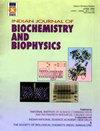相对于β-内酰胺酶抑制剂,水分子对β-内酰胺酶结合位点的作用及其动力学
IF 1.5
4区 生物学
Q4 BIOCHEMISTRY & MOLECULAR BIOLOGY
引用次数: 0
摘要
β-内酰胺酶水解β-内酰胺环的酰胺键。β-内酰胺类抗生素是抗生素体系中的主要武器库。β-内酰胺酶的高度突变和遗传变异提高了对β-内酰胺酶抑制剂的抗性。β-内酰胺酶有4类,即A、C、D类为丝氨酸蛋白酶,B类为金属蛋白酶。记录最多的是TEM,其中4个水分子(315、319、440、441)在结合位点起重要作用。在目前的工作中,我们试图解释水分子与S70(丝氨酸)、E166(谷氨酸)和N170(天冬酰胺)的对接行为,以及一个重要的Ω -环(R161-D179)的参与,该环对结合位点的行为进行变变调节。这将有助于我们确定与底物结合位点和β-内酰胺酶Ω -环以及它们与这4种水分子的相互作用精确相互作用的潜在候选抗生素。我们将Clavulanic acid (CA), Sulbactam (SB), Tazobactam (TB)与野生(1ZG4)和突变(1ZG6) TEM在HOH存在和不存在的情况下对接,这证明了水分子在β-内酰胺的水解以及调节潜在候选药物的结合亲和力中发挥重要作用的重要性。本文章由计算机程序翻译,如有差异,请以英文原文为准。
The role of water molecules and its dynamics to the binding site of β-lactamase enzyme with respect to β-lactamase inhibitor
β-lactamase hydrolyses amide bond of β-lactam ring. β-lactam antibiotics are the main arsenal in antibiotic regime. High degree of mutation and genetic variation in β-lactamase enzymes have elevated the resistance towards β-lactamase inhibitors. There are 4 classes of β-lactamase, namely Class A, C, and D which are Serine proteases and Class B is the Metallo proteases. The most documented one is TEM, where 4 water molecules (315, 319, 440, 441) play an important role in the binding site. In the present work we have tried to explain the involvement of water molecule with respect to docking behavior with S70 (Serine), E166 (Glutamate) and N170 (Asparagine) along with an important Ω – loop (R161-D179) which allosterically modulate the behavior of the binding site. This will aid us to identify potential candidates as novel antibiotics precisely interacting with the substrate binding site and Ω – loop of β-lactamase and their interaction with these 4 water molecules. We have docked Clavulanic acid (CA), Sulbactam (SB), Tazobactam (TB) with wild (1ZG4) and mutated (1ZG6) TEM in the presence and absence of HOH, which justifies the importance of water molecules playing an important role in the hydrolysis of β-lactam as well as modulating the binding affinity of a potential drug candidate.
求助全文
通过发布文献求助,成功后即可免费获取论文全文。
去求助
来源期刊

Indian journal of biochemistry & biophysics
生物-生化与分子生物学
CiteScore
2.90
自引率
50.00%
发文量
88
审稿时长
3 months
期刊介绍:
Started in 1964, this journal publishes original research articles in the following areas: structure-function relationships of biomolecules; biomolecular recognition, protein-protein and protein-DNA interactions; gene-cloning, genetic engineering, genome analysis, gene targeting, gene expression, vectors, gene therapy; drug targeting, drug design; molecular basis of genetic diseases; conformational studies, computer simulation, novel DNA structures and their biological implications, protein folding; enzymes structure, catalytic mechanisms, regulation; membrane biochemistry, transport, ion channels, signal transduction, cell-cell communication, glycobiology; receptors, antigen-antibody binding, neurochemistry, ageing, apoptosis, cell cycle control; hormones, growth factors; oncogenes, host-virus interactions, viral assembly and structure; intermediary metabolism, molecular basis of disease processes, vitamins, coenzymes, carrier proteins, toxicology; plant and microbial biochemistry; surface forces, micelles and microemulsions, colloids, electrical phenomena, etc. in biological systems. Solicited peer reviewed articles on contemporary Themes and Methods in Biochemistry and Biophysics form an important feature of IJBB.
Review articles on a current topic in the above fields are also considered. They must dwell more on research work done during the last couple of years in the field and authors should integrate their own work with that of others with acumen and authenticity, mere compilation of references by a third party is discouraged. While IJBB strongly promotes innovative novel research works for publication as full length papers, it also considers research data emanating from limited objectives, and extension of ongoing experimental works as ‘Notes’. IJBB follows “Double Blind Review process” where author names, affiliations and other correspondence details are removed to ensure fare evaluation. At the same time, reviewer names are not disclosed to authors.
 求助内容:
求助内容: 应助结果提醒方式:
应助结果提醒方式:


